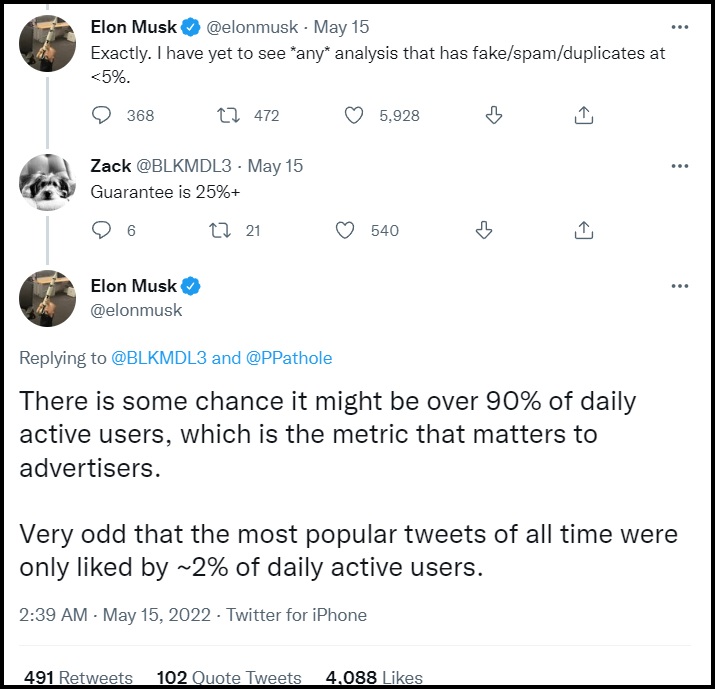
by Sundance at The Conservative Treehouse
The ramifications for Twitter surrounding fake users or algorithmic bots are considerable. One issue is overcharging advertisers for ad impressions based on mDAU’s, which are “monetized Daily Active Users.” The second issue is an outcome of the first and relates to the valuation of Twitter. If Twitter bots are higher than Twitter estimates, then the mDAU rate is overstated.
Elon Musk is indicating there may need to be a lowering of the purchase price unless Twitter becomes transparent with how they are calculating the number of bot users at less than 5%. All outside reviews attempting to estimate the number of fake accounts, or bots, puts the estimations considerably higher than the claims by Twitter. Elon Musk tweeted:

At “The All In Summit 2022,” Elon Musk gave the impression the purchase price of Twitter may be tenuous. He said that a deal with a lower price tag is not “out of the question,” Bloomberg reported. “Currently, what I’m being told is that there’s just no way to know the number of bots… It’s like, as unknowable as the human soul,” Musk said at the Miami conference, per a social media video, Bloomberg added.
Twitter CEO Parag Agrwal has responded to the controversy in a very obtuse twitter thread:
Let’s talk about spam. And let’s do so with the benefit of data, facts, and context…
First, let me state the obvious:
spam harms the experience for real people on Twitter, and therefore can harm our business. As such, we are strongly incentivized to detect and remove as much spam as we possibly can, every single day. Anyone who suggests otherwise is just wrong.
Next, spam isn’t just ‘binary’ (human / not human). The most advanced spam campaigns use combinations of coordinated humans + automation. They also compromise real accounts, and then use them to advance their campaign. So – they are sophisticated and hard to catch.
Some final context: fighting spam is incredibly *dynamic*. The adversaries, their goals, and tactics evolve constantly – often in response to our work! You can’t build a set of rules to detect spam today, and hope they will still work tomorrow. They will not.
We suspend over half a million spam accounts every day, usually before any of you even see them on Twitter. We also lock millions of accounts each week that we suspect may be spam – if they can’t pass human verification challenges (captchas, phone verification, etc).
The hard challenge is that many accounts which look fake superficially – are actually real people. And some of the spam accounts which are actually the most dangerous – and cause the most harm to our users – can look totally legitimate on the surface.
Our team updates our systems and rules constantly to remove as much spam as possible, without inadvertently suspending real people or adding unnecessary friction for real people when they use Twitter: none of us want to solve a captcha every time we use Twitter.
Now, we know we aren’t perfect at catching spam. And so this is why, after all the spam removal I talked about above, we know some still slips through. We measure this internally. And every quarter, we have estimated that <5% of reported mDAU for the quarter are spam accounts.
Our estimate is based on multiple human reviews (in replicate) of thousands of accounts, that are sampled at random, consistently over time, from *accounts we count as mDAUs*. We do this every quarter, and we have been doing this for many years.
Each human review is based on Twitter rules that define spam and platform manipulation, and uses both public and private data (eg, IP address, phone number, geolocation, client/browser signatures, what the account does when it’s active…) to make a determination on each account.
The use of private data is particularly important to avoid misclassifying users who are actually real. FirstnameBunchOfNumbers with no profile pic and odd tweets might seem like a bot or spam to you, but behind the scenes we often see multiple indicators that it’s a real person.
Our actual internal estimates for the last four quarters were all well under 5% – based on the methodology outlined above. The error margins on our estimates give us confidence in our public statements each quarter.
Unfortunately, we don’t believe that this specific estimation can be performed externally, given the critical need to use both public and private information (which we can’t share). Externally, it’s not even possible to know which accounts are counted as mDAUs on any given day.
There are LOTS of details that are very important underneath this high-level description. We shared an overview of the estimation process with Elon a week ago and look forward to continuing the conversation with him, and all of you. (Link to Twitter Article)
Methinks Parag Agrwal doth protest too much…. Especially if you overlay the ideological incentives that Twitter carries into its operational platform…
Continue Reading